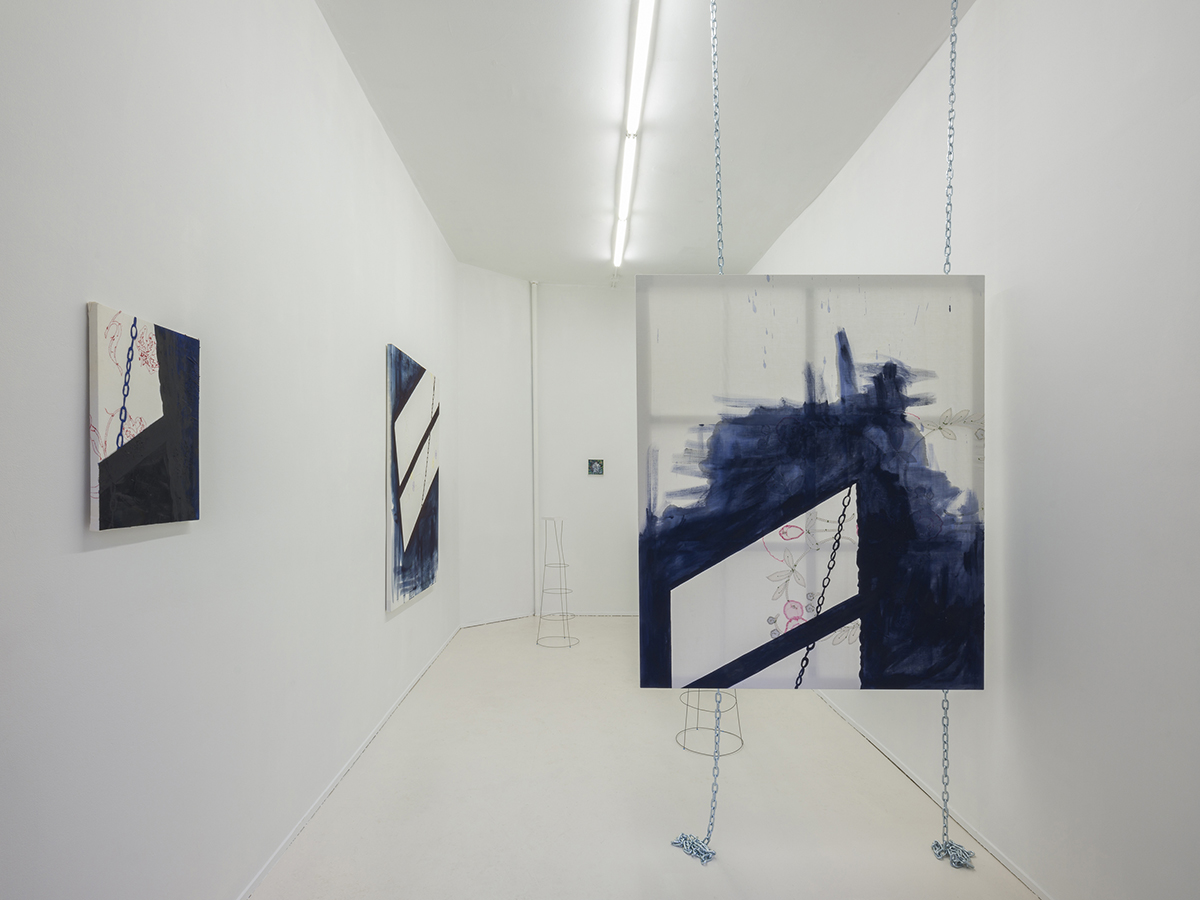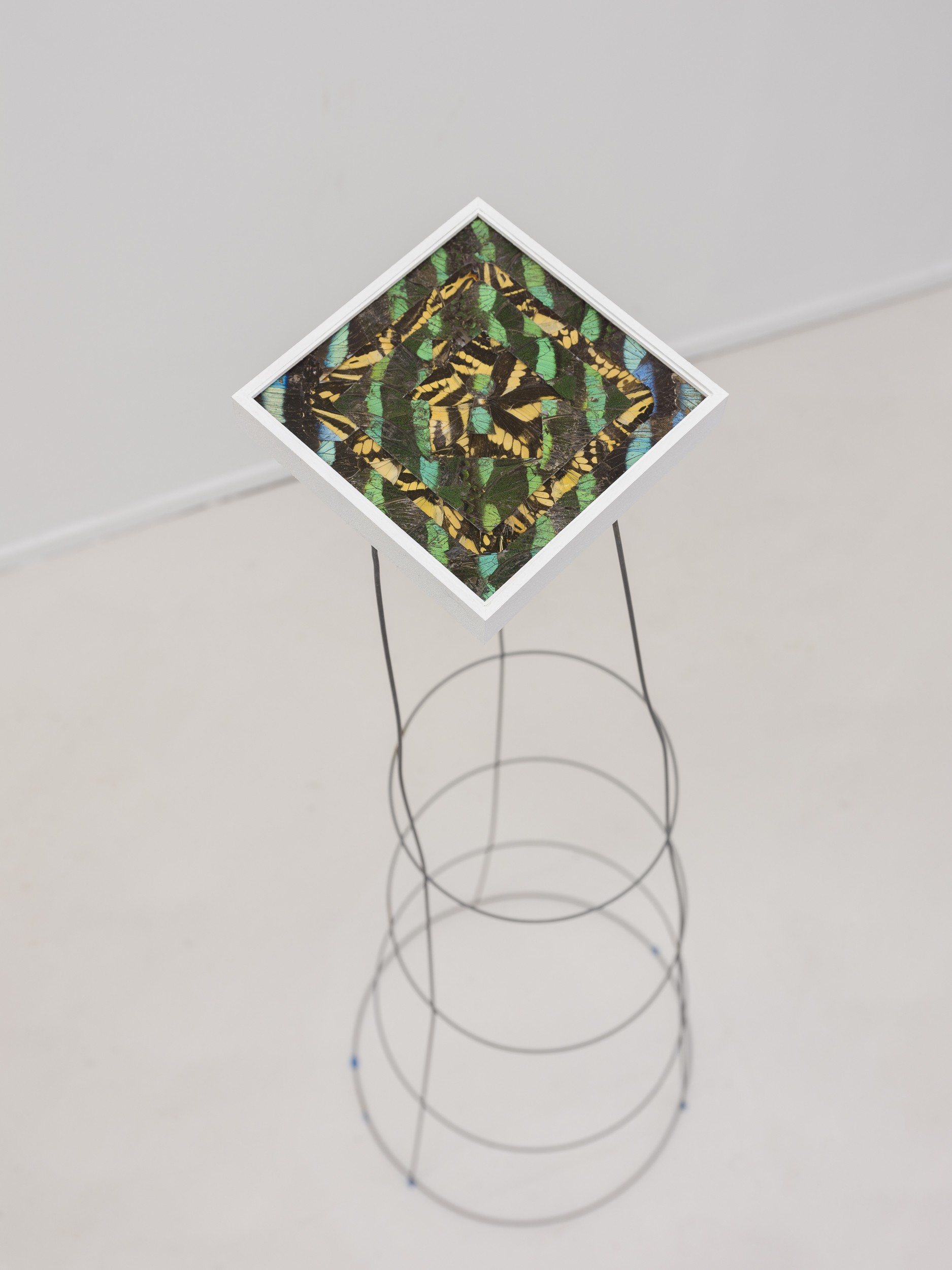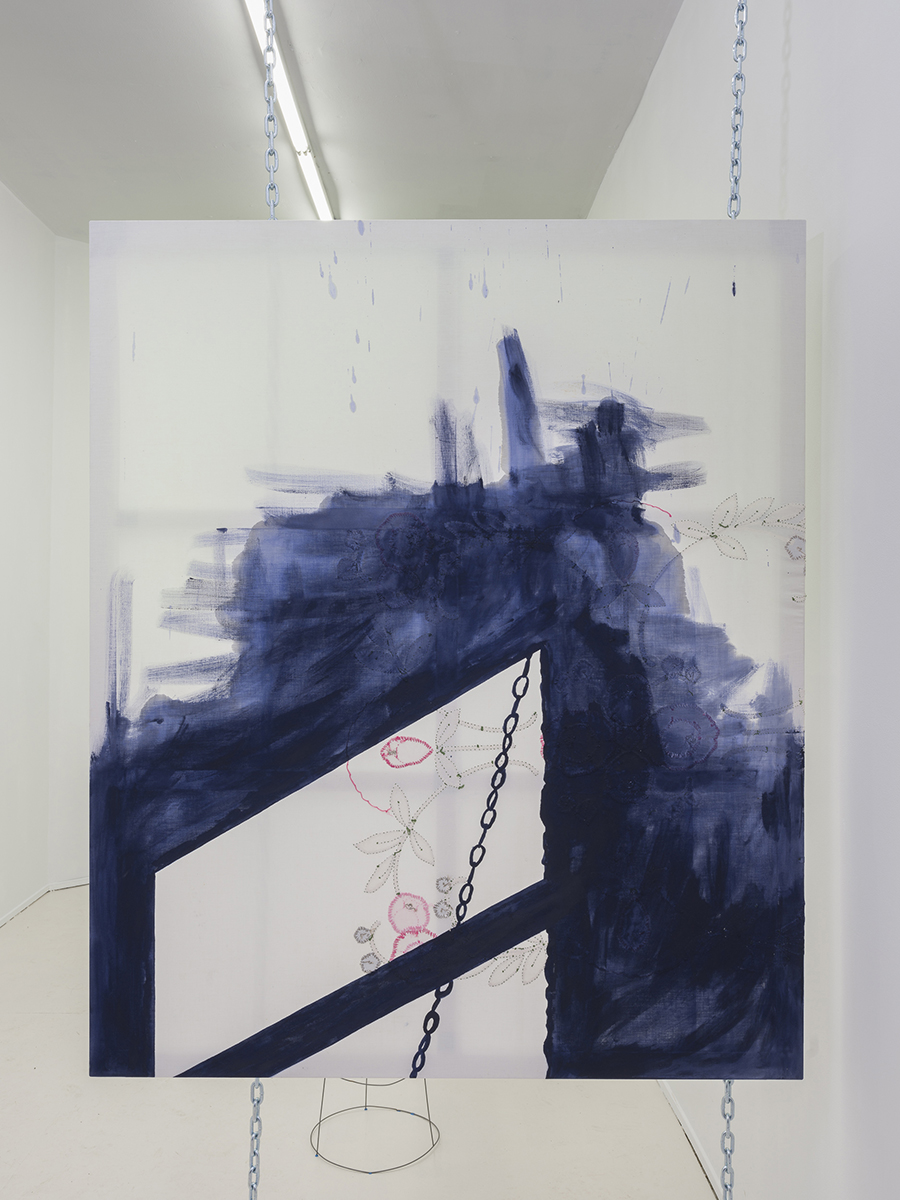LINNEA VEDDER
Soft SkillsFebruary 9 - March 10, 2019
Opening Reception: Saturday, February 9, 5-7PM

Morpho Scrap 2, 2019, 6"x6"x42", Butterfly wings, Tomato support, Artist's frame
Essex Flowers is pleased to present Soft Skills, a solo exhibition by Linnea Vedder.
For this show, Linnea Vedder has made a set of small white square frames, in which delicately layered butterfly wings are encased alongside paintings which respond to their patterns. Cut to reveal the corporate logos of familiar and less-familiar home security companies, the paintings sit atop overturned tomato cages (caging a tomato provides an artificial support which overrides the tomato’s natural and unhealthy inclination to spread across the ground). The fragile wings, collected after the butterflies are already deceased, are positioned in contrast with the boldness of Vedder’s compositions . In addition, she has painted the intruding shadow of a metal chain on the back of found blankets. The boldness of the painted image leaves what might be on the front of the blanket to the viewer’s imagination. The title of the show Soft Skills refers to the soft and hard materiality of the imagined and actual materials of chain, cloth, wings, and garden cages; to the concept of “personal” skills and emotional intelligence and how they are taught; to the way that we collectively and individually parent; and to the idea of curation, in the root sense of the word cura-, meaning care.
There is a kind of shiny blue-green wasp whose female uses a living cockroach as an edible incubator for her child. The wasp ambushes the cockroach and stings it once on the thorax, which causes a two to three minute paralysis of the cockroach’s front legs. Once the legs fold up and stop moving, the cockroach assumes a head-down position and the wasp can deliver a very precise sting to the sub-esophogeal ganglion, eliminating, most importantly, the cockroach’s escape reflex. The dopamine in the venom causes the cockroach to impulsively groom itself, repeatedly running its long antennae through its mouth. While the cockroach stands in place cleaning itself, the wasp goes off to find a hole to use as a nest. When the grooming ends the cockroach becomes sluggish. The wasp returns and bites off a portion of one of the cockroach’s cleaned antennae, and then, using the remaining part like a straw, sucks the fluid out of it. People speculate that she does this either to test the strength of her venom or to get a little extra vitamins and liquid; no one is sure. She then grabs the antenna with her mouth and leads the cockroach, whose legs obediently walk forward, toward the nest she’s chosen. After maneuvering the cockroach into the bottom of the hole, she lays a single egg on the cockroach’s middle leg, after which she fills in the entrance of the burrow to prevent predators from finding and eating both the cockroach and the egg.
Although the stung cockroach is unable to walk of its own will, studies in laboratories have shown that it retains the ability to fly, swim, and right itself after being flipped over. Research also found that the sluggishness, or what they call hypokinesia, lasts for two to five weeks after the cockroach is stung. When I first learned about this experience certain cockroaches have, I was dating someone who was often severely depressed. There are a few videos of the process, which I watched one night on Youtube. The following morning I did yoga. While in chaturanga, with my head close to the floor, I saw something that immediately, but only for an instant, registered with horror in my mind as a cockroach antenna. This mini hallucination showed me how affected my mind was by the videos, and in realizing this I also realized that what happens to the cockroach disturbed me because I thought, the man I am with is in an excruciating state, but just like the cockroach lacks the escape reflex to help himself get away.
Two or three days after the cockroach is buried in the burrow, the egg hatches into a larva. The larva feeds on the cockroach for four or five days before chewing a hole in the cockroach’s exoskeleton through which it crawls inside its abdomen. For eight days it spits out an antibiotic fluid, which is spreads on the cockroach’s organs before consuming them one by one in specific order, leaving the gut and nervous system intact, presumably to prolong the cockroach’s life. Eventually the larva makes an antimicrobial cocoon inside the cockroach to protect against the inevitable rot when the cockroach dies, and a fully-formed wasp emerges from the carcass about forty days later.
Science has not yet confirmed or denied whether insects feel pain, so some of them might say the cockroach does not endure weeks of brutal and confusing agony, while its body twitches as it’s methodically dismantled. Pain is defined as an emotional experience, not as a purely physical one, so even though fruit flies will react negatively to a heated needle; or sea slugs repeatedly tortured in the laboratory become ultra-sensitive to pain stimuli and begin withdrawing from what would otherwise be normal interactions (the condition is called allodynia, a factor in diseases such as fibromyalgia); or praying mantises’ reactivity to electric shock is reduced with morphine, scientists remain unconvinced that bugs feel pain. But insects can heal. Scientists have cut the legs of locusts to confirm this; tarantulas when well cared for can regain their limbs after devastating injury; and people have also observed a certain ant species which carries its wounded back to the colony and nurses them by licking their hurt legs.
- Elise Duryee-Browner
Linnea Vedder is an artist living and working in New York City. She has had solo shows at Lubov Gallery, NYC, The Boom Boom Room, Brooklyn, and Spare Room Projects, Brooklyn. She has published a book of illustrations called "The World is Your Oracle", and released three albums under the moniker "Lights".












